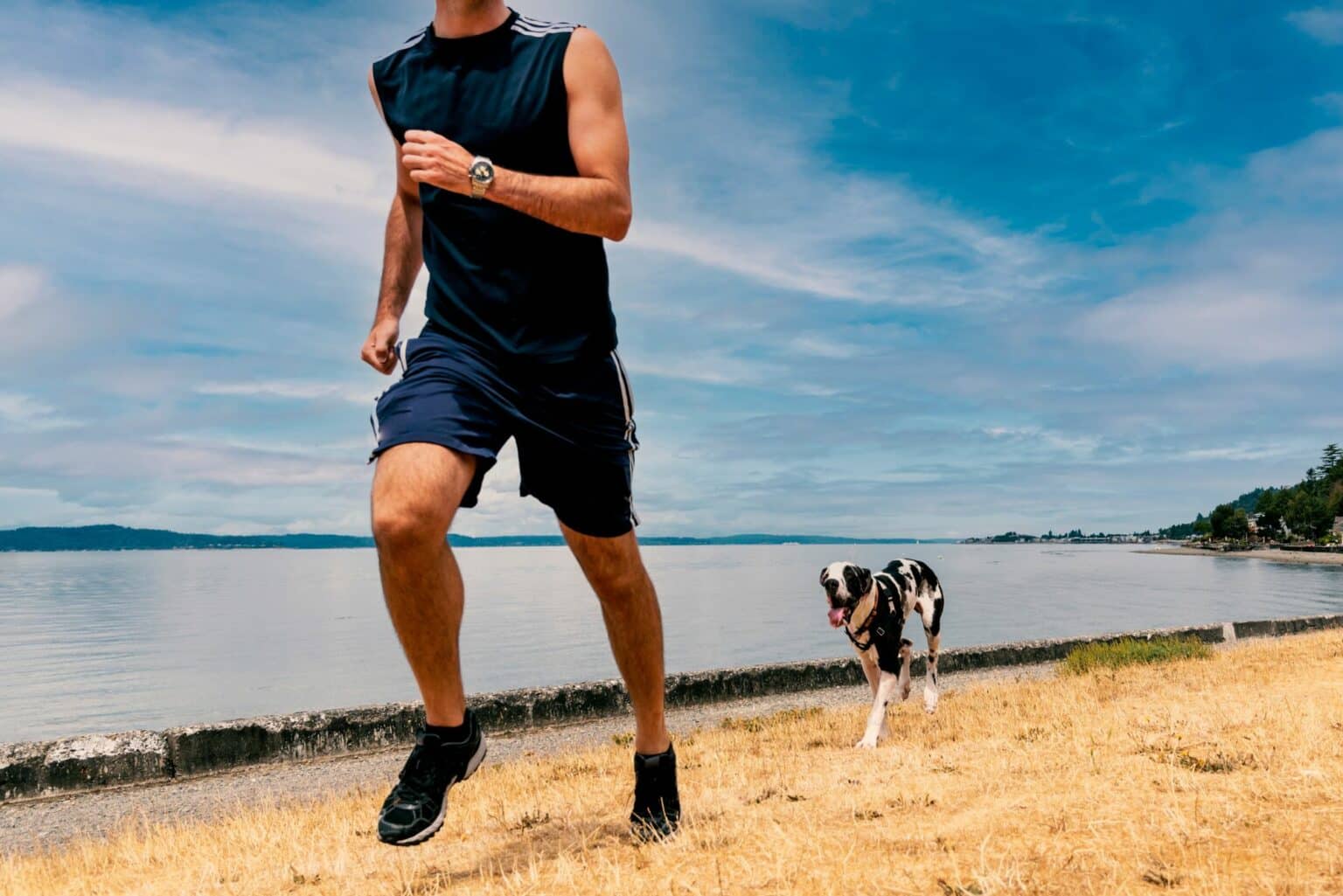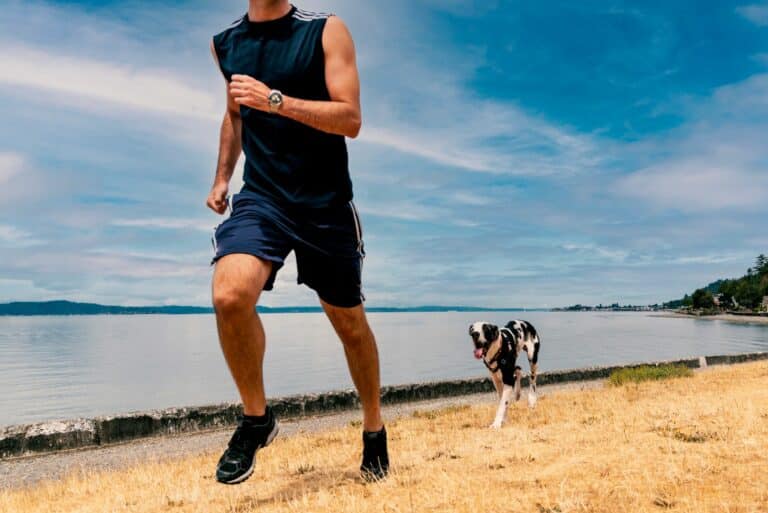


As much as we love taking our furry companions on runs with us, it’s important to remember that dogs have physical limitations just like humans do. While some breeds are better suited for long-distance running, others may struggle and become injured if pushed too far. As a responsible dog owner, it’s up to you to determine how far is too far when running with a dog.
Before taking your dog running, it’s essential to make sure they are properly trained and have basic obedience skills. This includes responding to commands like “heel” and “stop,” as well as being able to walk or run on a leash without pulling.
It’s also important to warm up before starting the run. A short five to 10 minute walk or jog can help loosen up your dog’s muscles and prevent injury.
During the run, it’s important to keep an eye on your dog and check in with them regularly. Signs of fatigue or discomfort may include excessive panting, slowing down, or refusing to continue. If you notice any of these signs, it’s best to stop the run and give your dog a break.
Leash training and basic obedience skills are crucial for running safely with your dog. Not only does it prevent them from pulling or getting distracted, but it also allows you to have better control in potentially dangerous situations.
To train your dog on a leash, start by teaching them the “heel” command. This means walking or running alongside you without pulling or straying too far. Practice this in a distraction-free environment before gradually introducing them to more stimulating surroundings.
It’s also important to teach your dog basic obedience commands like “stop” and “come.” These can be useful in emergency situations or when you need to quickly grab their attention during a run.
Remember to always use positive reinforcement and rewards when training your dog. This will help most dogs associate running with a positive experience, making it more enjoyable for both of you.
Aside from the physical benefits of running, there are many other reasons why including your dog in your runs can be a great idea.
With proper preparation and training, you can make running with your dog a rewarding experience for everyone involved. So, grab your running shoes and leash up your furry friend – it’s time to hit the pavement together.
Not all dogs are built for running. Some have physical limitations that may make them unsuitable for long-distance or high-intensity runs. Here are some of the best dog breeds for running:
Remember, every dog is different and may have varying levels of energy and physical capabilities. Brachycephalic dogs with short snouts, such as Bulldogs and Pugs, may struggle with running due to breathing difficulties.
Running is a high-impact activity, so it’s important to properly train your dog regularly before taking them on a run. This includes building up their endurance and ensuring they have proper leash manners before you have your dog join you on a run.
Start by incorporating short walks or jogs into your daily routine to help build your dog’s stamina and get them used to running alongside you. Gradually increase the distance and intensity over time.
It’s also important to vary the terrain and distance of your runs to prevent boredom and overexertion. This can also help strengthen different muscle groups in your dog’s body.
Remember to always listen to your dog and adjust the run accordingly. If they show signs of fatigue or discomfort, slow down or stop for a break.
With patience, consistency, and positive reinforcement, you can train your dog to be a great running partner. And who knows – they may even motivate you to run that extra mile! So get out there and enjoy the many benefits of running with your furry friend.

After a run, it’s important to take care of your dog’s recovery, just as you would for yourself. This includes:
It’s also important to monitor your dog’s movement regularly for any signs of fatigue or discomfort after a run. If they seem excessively tired or show any symptoms of pain, it’s best to consult with a veterinarian.
By taking care of your dog’s wellbeing, you can ensure they stay healthy and injury-free for future runs together. And, of course, don’t forget to reward them with lots of love, treats, and praise – they deserve it!
Running with your dog off-leash can be a fun and freeing experience for both of you. However, it’s essential to ensure their safety and the safety of others when letting them run free.
Firstly, make sure you are in an area where it is safe and legal for dogs to be off-leash. Look out for any potential hazards, such as roads or bodies of water, that could pose a danger to your dog.
It’s also important to have good recall training with your dog. This means they will come back to you when called, even when distracted by other animals or scents. Practice this in a controlled environment before attempting it on a run.
Finally, always keep an eye on your dog and their behaviour while off-leash. If they start to show any signs of aggression or become too excited, it may be best to leash them up again.
With proper training and precautions, running with your dog off-leash can be a fun and exhilarating experience for both of you. Just remember to always prioritise safety first.
Before starting any new exercise routine with your dog, it’s crucial to check with your veterinarian. They can evaluate your dog’s overall health and make sure they are physically fit for running.
Certain breeds or individual dogs may have existing health conditions that could be aggravated by running, so it’s best to get a professional opinion before hitting the pavement.
Your vet can also provide advice on any necessary vaccinations or preventive measures to keep your dog safe while running.
Just like humans, dogs need time to build up their endurance for running. Jumping into long runs too quickly without proper training can lead to injuries or exhaustion.
Start with shorter runs and gradually increase the distance over time, allowing your dog’s body to adjust and strengthen. Pay attention to their behaviour and energy levels during and after a run – this can help you assess when it’s time to increase the distance or intensity.
The distance your dog can run depends on a variety of factors, such as their age, breed, overall health, and individual fitness level. It’s important to assess your dog’s capabilities and build up their endurance gradually.
It’s also essential to consider the weather when planning a run with your dog. Dogs can easily overheat in hot temperatures, so it may be best to limit their runs or run during cooler times of the day.
Additionally, some breeds may not be suitable for long-distance running due to physical limitations. Always consult with your veterinarian and listen to your dog’s cues when determining how far they can run.
There are a few important commands that you should make sure your dog understands before going on a run with you. These include:
It’s crucial to practice these commands in a controlled environment before attempting them on a run with your dog.
While it’s not necessary to have specific gear for running with dog, there are a few items that can make the experience more comfortable and safe for both of you. These include:
Remember to also bring along essentials like water, treats, and waste bags while running with your dog.
Before heading out for a run, it’s important to check the weather conditions. Extreme temperatures, such as hot and humid weather or freezing temperatures, can be dangerous for your dog.
If you plan on running in warmer temperatures, make sure to bring along water and take frequent breaks to allow your dog to cool down. In colder temperatures, consider layering up your dog with a coat or jacket to keep them warm.
Every dog is different, so it’s important to listen to your dog and adjust accordingly when running with them.
By following these tips and guidelines, you can safely enjoy the many benefits of running with your furry companion by your side.
Canicross is a sport that involves running with your dog while attached by a harness and bungee line. It originated in Europe as a way for people to participate in outdoor activities with their dogs and has gained popularity worldwide.
These events often include cross-country races or obstacle courses, testing the physical capabilities and teamwork of both the human and canine participants.
Canicross events are a fun and challenging way to bond with your dog, meet other like-minded owners, and showcase the incredible abilities of our furry companions. So why not look at our CoachtheRun events page and sign up for a Canicross event near you and experience the joys of running with your dog in a new way?
Ready for a speedy marathon challenge? Take a read of our 4 hour pace marathon blog.
So, grab your running shoes and leash up your furry friend – it’s time to hit the trails together.
Join our mailing list to stay up to date with the latest UK running events, training tips, and exclusive offers on running products. Rest assured, we value your privacy and would never dream of selling your address. Sign up now…
Share this article
Running a marathon is one of the most challenging athletic feats. It requires months of...
As a runner, you understand the importance of having a solid training plan and proper...
A few years ago, I received a phone call from Adrian Chiles, the television and...
Running is a great way to stay fit and healthy, but it can also be...
Trail running offers a wonderful escape into nature. Unlike road running, which involves constant pavement...
Kettlebells, a popular type of weight training equipment originating from Russia, consist of a cast...
We’re here to make sure you’re up-to-date with the latest running tips, events and product discounts – we’ve always got your back! Rest assured, we value your privacy and would never dream of selling your address.
BONUS: Sign up today and receive a FREE code for our Sub-4-Hour Marathon Plan